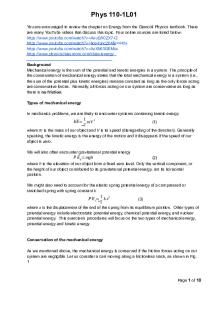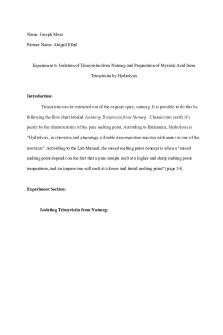Lab Report 5 - lab PDF

| Title | Lab Report 5 - lab |
|---|---|
| Author | Anonymous User |
| Course | Organic Chemistry Laboratory Ii |
| Institution | Texas Tech University |
| Pages | 5 |
| File Size | 208.9 KB |
| File Type | |
| Total Downloads | 18 |
| Total Views | 183 |
Summary
lab...
Description
Melody Vinson Lab Partner – Jennifer Agu 10.5.2020 , CHEM 3105-303 TA - Liulei Ma
Thin Layer Chromatography of Analgesics and IR Spectroscopy
Purpose To find the components of over the counter analgesic and learning how to do thin layer chromatography and IR spectroscopy.
Safety Methanol Hazard Statements: • • •
Highly flammable Can cause organ damage Is toxic in ingested or if it comes in contact with skin
Ethyl Acetate Hazard Statements: • • •
Highly flammable Can cause severe eye irritation Can cause dizziness and drowsiness
Hexanes Hazard Statements: • • • •
Highly flammable Can be fatal if ingested Can cause eye, skin, and respiratory irritation Can cause damage to fertility
Acetic Acid Hazard Statements: • •
Flammable Can cause skin and eye damage
Procedure 1. Prepare set of solutions with the active components and over the counter drugs.
2. For each solution add 10 mg of the sample to a shell vial with 1 mL of methanol, then swirl and label.
3. Prepare developing solution with 7.5 mL of ethyl acetate with 3 mL of hexane inside of a 250 mL beaker.
4. In the fume hood and add 10 drops of acetic acid and swirl.
5. Prepare the TLC plates, draw lines gently, 1 cm above the top and bottom of the TLC plate.
6. Mark five even spots on both sheets.
7. Use a spotting capillary to place a small amount of methanol solution of the analgesics on the appropriate dots, it should quickly evaporate.
8. After all compounds are spotted, rinse the TLC plate with methanol and pat dry.
9. Test spots under the UV lamp to make sure they are strong enough, then set the TLC plate standing up in the developing solution and cover with watch glass.
10. Wait until the solvent reaches the top line of the TLC plate and then take it out and mark the top with a pencil.
11. Now observe the plate with a UV lamp, then mark the spots with a pencil and label them and record this in your notebook. Measure the distance between the bottom line and each spot and record this is the A value.
12. The B value is the distance between the bottom line and the highest point the developing solution reached, record this value.
13. Use these samples to compare and find the identity of your unknown.
14. Dispose of solutions and materials in their appropriate ways and places.
Data/Observations The unknown and Motrin traveled the same and farthest distance, while Anacin traveled the shortest distance. Groups 1 2 3 4 5 6 7 8 9 10
Analgesic Acetaminophen Acetylsalicylic Acid Caffeine Ibuprofen Unknown Anacin Aspirin Excedrin Motrin Tylenol
Distance (B, in cm) 3.2 5.0 1.3 4.9 6.0 1.0 5.8 3.8 6.0 4.0
The peak for the double CO bond peaks at 1640 cm-1 on the IR spectra.
Calculations/Results Rf=a/b Groups 1 2 3 4 5 6 7 8 9 10
Analgesic Acetaminophen Acetylsalicylic Acid Caffeine Ibuprofen Unknown Anacin Aspirin Excedrin Motrin Tylenol
Rf Value .52 .81 .21 .79 .97 .17 .97 .63 1.0 .67
Conclusion/Discussion The experiment was overall successful and properly taught how to use TLC plates, how to find components of over the counter drugs like analgesics and how to use the IR spectra, then using this information to be able to kind unknown. In conclusion, through the experiment and calculations I determined that the unknown is the same as group 2 which is Motrin because of a value. Functional components of the groups and their Rf values have to do with their strong intermolecular forces. This study is important in the field of pharmacologists and medicine development.
Post Lab Questions 1. Where did you observe the O-H and/or C=O peaks (depending on which compound you used) in the IR spectrum of the compound for which you acquired a spectrum?
I observed the peaks in the IR spectrum from 3200 to 3400 cm-1 for the OH bond, and 1640 to 1800 cm-1 for the CO double bond.
2. How do the O-H and/or C=O peaks in your spectrum obtained in lab compare to the O-H and/or C=O peaks seen in the reference spectrum (located in Experiment 5 folder on Blackboard) for the same compound?
These don’t have correlation with the spectra as it shows differing results when it has other molecules connected.
3. Which of the three compounds has a O-H group and how do the O-H peak locations in the IR spectra compare?
Alcohol was 3200 to 3400 cm-1, acid was 2500 to 3400 cm-1, and the aromatic acid was 1690 cm-1.
4. Which of the three compounds has a C=O group and how do the C=O peak locations in the IR spectra compare?
For the aldehyde it was 1725 to 1690 cm-1, ketone was 1715 to 1680 cm-1, and ester was 1735 to 1720 cm-1.
5. If benzyl alcohol, benzaldehyde, and benzoic acid were chromatographed using silica gel TLC plates, which should have the largest Rf value? Explain why. Benzioc acid because highest Rf means that there is a lot more affinity present than solvent, and has the highest polarity, because it has a free hydrogen.
Sources (n.d.). Retrieved October 07, 2020, from https://app.tophat.com/e/221396/assigned/...
Similar Free PDFs

LAB 5 - Lab report
- 4 Pages

Lab Report 5 - lab
- 5 Pages

Lab 5 - Lab report
- 6 Pages

Lab 5 - Lab experiment report
- 6 Pages

Lab 5 Lab Report- (Microbiology)
- 4 Pages

Phys lab 5 - Lab report
- 10 Pages

Post Lab Report Lab 5
- 5 Pages

Lab Report 5
- 8 Pages

Lab Report 5
- 16 Pages

Lab 5 Report
- 5 Pages

Chem lab report 5
- 7 Pages

Lab 5 Report
- 8 Pages

EX 5 lab report
- 10 Pages

Lab report 5
- 13 Pages

Lab Report 5
- 6 Pages

Physics lab report 5
- 7 Pages
Popular Institutions
- Tinajero National High School - Annex
- Politeknik Caltex Riau
- Yokohama City University
- SGT University
- University of Al-Qadisiyah
- Divine Word College of Vigan
- Techniek College Rotterdam
- Universidade de Santiago
- Universiti Teknologi MARA Cawangan Johor Kampus Pasir Gudang
- Poltekkes Kemenkes Yogyakarta
- Baguio City National High School
- Colegio san marcos
- preparatoria uno
- Centro de Bachillerato Tecnológico Industrial y de Servicios No. 107
- Dalian Maritime University
- Quang Trung Secondary School
- Colegio Tecnológico en Informática
- Corporación Regional de Educación Superior
- Grupo CEDVA
- Dar Al Uloom University
- Centro de Estudios Preuniversitarios de la Universidad Nacional de Ingeniería
- 上智大学
- Aakash International School, Nuna Majara
- San Felipe Neri Catholic School
- Kang Chiao International School - New Taipei City
- Misamis Occidental National High School
- Institución Educativa Escuela Normal Juan Ladrilleros
- Kolehiyo ng Pantukan
- Batanes State College
- Instituto Continental
- Sekolah Menengah Kejuruan Kesehatan Kaltara (Tarakan)
- Colegio de La Inmaculada Concepcion - Cebu